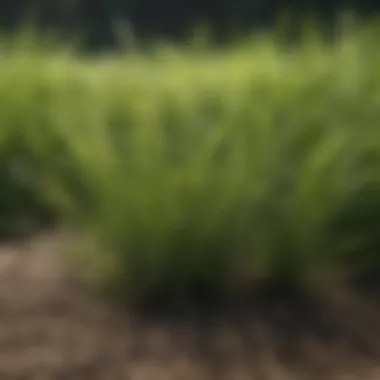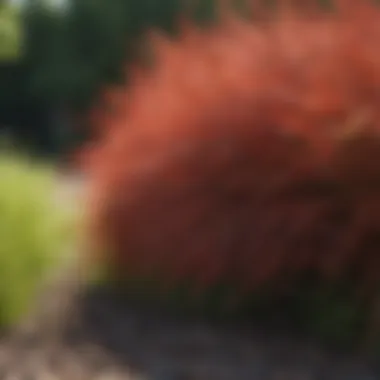Exploring the Different Kinds of Fescue Grass


Intro
Fescue grass has gained attention not only for its aesthetic appeal but also for its utility in various settings. This grass type is adaptable to different environments and serves multiple purposes in agriculture and landscaping. Understanding the various types of fescue can help farmers, gardeners, and horticulturalists make informed choices about their cultivation practices. This article will explore the significant characteristics and applications of fescue grass, providing key insights into its relevance in modern agriculture and landscaping.
Current Trends in Agriculture and Horticulture
Overview of Recent Innovations
In recent years, innovations in agricultural practices have increasingly spotlighted fescue grass due to its resilient nature. Varieties such as Kentucky tall fescue have been engineered to withstand drought and extreme temperatures. These innovations focus on enhancing grass types suitable for diverse climates. Such advancements allow farms to be more sustainable while minimizing resource use, leading to overall improved productivity.
Sustainable Practices Gaining Popularity
As sustainability takes center stage, fescue grass emerges as an excellent option for environmentally conscious farmers. The benefits of fescue include:
- Improved soil health through deep roots that prevent erosion.
- Reduced water usage compared to traditional turf grasses.
- Enhanced biodiversity, supporting various plant and animal species.
These sustainable attributes make fescue grass an appealing choice for landscapers and agriculturalists aiming to align with eco-friendly practices.
Essential Farming Techniques
Soil Health Management
To optimize the growth of fescue grass, attention to soil health is essential. Soil testing can identify nutrient needs and pH levels. Adjustments can be made accordingly, such as adding lime or specific fertilizers. Implementing crop rotation with legumes can also enrich the soil, promoting a healthier growing environment for fescue.
Pest and Disease Control Strategies
Maintaining fescue grass requires vigilance against pests and diseases. Integrated Pest Management (IPM) is an effective approach, focusing on:
- Monitoring pest activity through regular inspections.
- Utilizing biological controls, like beneficial insects.
- Applying chemical controls only when necessary and in a targeted manner.
This strategy fosters a balance, reducing the need for harsh chemicals and maintaining ecological harmony.
Tools and Technology in Farming
Overview of Advanced Farming Tools
Farming technology is evolving rapidly. New tools enhance the productivity and management of fescue grass cultivation. Precision agriculture employs GPS technology for effective planting and resource use. Drones can survey fields, offering insights into plant health and irrigation needs.
Case Studies on the Use of Technology
Several case studies demonstrate the successful application of technology in managing fescue grass.
- In California, farmers use drones to monitor the health of their fields. This method allows for timely interventions that improve yields.
- In the Midwest, precision irrigation systems minimize water waste while ensuring optimal growth for fescue.
These examples reflect the broader trend toward tech integration in agriculture.
"Fescue grass exemplifies the harmony between modern agriculture and ecological sustainability."
By understanding the various types of fescue grass, their characteristics, and how to manage them effectively, farmers and enthusiasts can make better choices for their needs.
Prelude to Fescue Grass
Fescue grass holds significance in both agriculture and landscaping. As a group of grasses that are versatile and resilient, they serve various purposes from creating lush lawns to maintaining soil health. This section provides an essential overview, helping readers understand why fescue grass deserves attention.
Definition and Overview
Fescue grass refers to a group of grasses classified under the genus Festuca. This genus comprises numerous species, each with unique traits and advantages. Fescue is characterized by its fine to medium leaf texture and dense growth habit. It thrives in different environments, making it popular for residential lawns, sports fields, and pasturelands.
Key characteristics include:
- Drought resistance: Fescues are known for their ability to tolerate dry conditions, which is valuable for sustainable landscaping.
- Shade tolerance: Certain types of fescue can survive under tree cover, allowing them to flourish in less sunny areas.
- Low maintenance: Compared to other grass types, fescue often requires less care, such as less frequent mowing and watering.
Understanding these features is crucial for anyone considering fescue grass for their project or landscape design.
Historical Significance
The historical roots of fescue grass extend back many centuries. Initially, it was primarily used for grazing livestock. Its hardy nature made it an ideal option for farmers looking to provide nutritious forage for cattle and sheep. Over time, the versatility of fescue led to its use in various applications beyond farming.


In the late 20th century, there was a surge in interest for using fescue in residential and commercial landscaping, primarily due to its adaptability and low maintenance needs. As environmental concerns grew, fescue became attractive for soil erosion control and water conservation. This shift reflects how fescue grass has evolved from a practical agrarian resource to a valuable component in modern landscaping.
"Fescue grass has been a staple in agricultural practices and is now embraced for its ecological benefits."
Types of Fescue Grass
Understanding the various types of fescue grass is crucial for any horticulturist or farmer. Each type comes with unique characteristics that influence not only its appeal but also its suitability for different environments and uses. By exploring the various types, we can make informed decisions when selecting the right fescue for landscapes, pastures, or recreational areas. This choice can impact ecosystem health, grazing efficiency, and overall landscape aesthetics.
Tall Fescue
Description and Characteristics
Tall fescue is known for its deep roots and tolerance to drought conditions. This grass can grow from 12 to 36 inches tall, featuring a broad, coarse texture. Its adaptability makes it popular in various regions. One of its key characteristics is the ability to thrive in transitional zones, where temperature extremes can challenge other grass types. Its durability contributes to its selection for lawns, sports fields, and hay production. The endophyte relationship in tall fescue can provide added resistance to pests and diseases, making it a favored choice in many agricultural settings.
Growth Patterns
The growth pattern of tall fescue is notable for its resilient nature. It has a culm development that leads to a robust structure, exhibiting growth predominantly during the warmer months. This grass can adapt to fluctuating temperatures, showing increased growth during spring and fall. It maintains vigor in poor soils, where other grasses would struggle. This adaptability to different climates offers significant advantages for homeowners and farmers alike, especially in regions with varying weather patterns.
Uses and Applications
Tall fescue is multifunctional, making it a versatile choice. It is often used in lawns, golf courses, and athletic fields due to its wear tolerance and ability to recuperate quickly. Additionally, its deep roots help in soil stabilization, promoting erosion control. It’s also used in pastures because of its suitability for livestock grazing. However, its coarse texture may not be aesthetically pleasing for some landscaping desires, so choosing tall fescue requires careful consideration of its environment and intended use.
Kentucky Bluegrass
Distinctive Features
Kentucky bluegrass is characterized by its rich, lush appearance. It has a fine leaf blade and creates a dense turf. One of its most distinctive features is its ability to self-repair, giving it resilience against wear and tear. This characteristic makes it a popular choice for residential lawns and parks. Its vibrant color is an added visual benefit, enhancing landscape appeal significantly. However, maintaining Kentucky bluegrass often requires a higher level of water and nutrient management compared to other grassy types.
Optimal Growing Conditions
Kentucky bluegrass thrives in cool, temperate climates. It prefers well-drained soils and needs sufficient sunlight for optimal growth. The ideal growing conditions revolve around moderate temperatures and periodic rainfall, making it a favorite in northern regions. Nonetheless, its dependence on these conditions can be a disadvantage in areas where drought is common. Proper care and management can help mitigate these challenges, ensuring healthier grass over time.
Common Uses
The versatility of Kentucky bluegrass allows it to be used in lawns, sports fields, and even erosion control in landscapes. It's particularly popular for residential and commercial landscaping due to its lush green appearance and adaptability to various soil types. Nevertheless, its higher maintenance needs, particularly in terms of watering, mean that it might not suit everyone’s circumstances, especially in arid regions.
Fine Fescue
Types of Fine Fescue
Fine fescue includes several types like creeping red fescue, chewings fescue, and hard fescue. Each type is distinguished by its texture and growth habits. For example, creeping red fescue is known for its fine leaves and shade tolerance, while hard fescue is associated with seedling resilience in tougher conditions. Fine fescue's key characteristic is its fine texture, which allows it to blend well into various grasses for optimal lawn mixes.
Growth Considerations
The growth considerations for fine fescue focus on its preference for cooler environments. It establishes quickly and grows well in shaded areas. While fine fescue does not demand as much water as other grasses, it does need good drainage to avoid disease. The advantage of its drought resistance is significant, particularly for environmentally conscious gardeners or farmers.
Landscaping Applications
Fine fescue is very suitable for low-maintenance lawns and can contribute to eco-friendly landscaping. Its fine texture offers a soft appearance and is often used in blends for expansive landscapes or areas with limited foot traffic. However, because of its lower tolerance for heavy wear, it may not be ideal for high-traffic areas or sports fields.
Hard Fescue
Characteristics and Benefits
Hard fescue is known for its exceptional drought resistance and ability to thrive in low-fertility soils. This grass has a fine texture and is more durable than its fellow fine fescue types. Its benefits include minimal maintenance needs and its adaptability to less-than-ideal soil conditions. This makes hard fescue an attractive option for sustainable landscaping.
Shade Tolerance
Hard fescue's shade tolerance opens up possibilities in the landscaping of wooded spaces or near buildings. It performs adequately even when sunlight is limited, which is not common amongst many grasses. This ability creates opportunities for diverse lawn designs, allowing homeowners to utilize shaded areas productively.
Maintenance Requirements
This grass requires less fertilizer and watering than other types, making it environmentally friendly. However, its slow establishment can be considered a drawback, as it takes time to form a thick lawn. Understanding these maintenance aspects leads to more sustainable landscape management practices, contributing positively to the environment.
Sheep Fescue
Growth Habits


Sheep fescue, known for its hardy growth habits, has a fine texture that adapts well to poor soils. It establishes easily and forms a dense turf, contributing to soil stability. The growth habit allows it to remain competitive with weeds, providing an advantage in pasture settings. Farmers value it for its ability to thrive in less fertile soils without heavy fertilization.
Applications in Grazing
Sheep fescue is primarily used in grazing systems due to its nutrient density. Its preferred application is as a forage for sheep and other livestock, offering significant forage production. The adaptability to grazing conditions makes it a prime choice for rotational grazing systems, allowing for sustainable land management.
Environmental Benefits
The environmental benefits of sheep fescue are notable, as its ability to grow in poor soils prevents erosion and promotes biodiversity. Areas replanted with sheep fescue often show improved soil structure, encouraging healthier ecosystems. Farmers adopting sheep fescue can experience increased resilience within their land, contributing to long-term agricultural sustainability.
Growing Conditions for Fescue Grass
Growing conditions are crucial for the successful cultivation of fescue grass. Understanding soil preferences, sunlight requirements, and watering needs ensures optimal growth and health of this grass type. This section addresses the specific factors that influence the vigor and resilience of fescue species, shedding light on how to create favorable environments for their development while maximizing their benefits.
Soil Preferences
Fescue grass thrives best in well-drained soils that have a good balance of nutrients. Ideal soil pH ranges from 6.0 to 7.0, allowing for optimal nutrient availability.
- Loamy soils are often preferred due to their structure that promotes root development.
- Clay soils can be suitable if proper drainage measures are taken, but they may lead to water retention issues.
- Sandy soils, while good at draining, may not hold enough nutrients unless amended.
Testing soil composition periodically helps determine if any amendments are necessary to enhance growth. Organic matter can improve soil fertility, aiding in better root establishment.
Sunlight Requirements
Fescue grass has varying sunlight needs based on its type. Tall fescue and fine fescue, for instance, can adapt well to partial shade, while Kentucky bluegrass requires more sunlight for optimal growth.
- Full sun is preferred for best results, ideally receiving around 6-8 hours of direct sunlight daily.
- In shaded areas, fescue can still grow but tends to be less vigorous and may require more careful management. The adaptation of different fescue types to sunlight must be understood for successful lawn establishment.
Watering Needs
Proper watering is essential to support growth and maintain the health of fescue grass. Over-watering or under-watering can lead to issues such as root rot or drought stress. Generally, fescue requires 1 to 1.5 inches of water per week, which can be adjusted based on weather and soil conditions.
- Irrigation systems should be used to ensure consistent moisture, especially in dry spells.
- Watering in the early morning is best to reduce evaporation and fungal diseases.
"Successful grass management begins with understanding its needs and addressing them accordingly."
Monitoring moisture levels using tools like moisture meters can help avoid over- or under-watered conditions. Each component of fescue grass’ growing conditions contributes significantly to its growth success. By adapting these elements, one can cultivate a lush, resilient lawn or pasture.
Cultivation Techniques
Cultivation techniques are crucial for growing fescue grass effectively. They influence germination, health, and overall growth. Understanding proper methods allows for better establishment and maintenance of the grass. This section outlines key techniques including sowing methods and fertilization guidelines, which can help ensure a thriving fescue lawn or pasture.
Sowing Methods
Seed Selection
Seed selection is an important step in establishing any fescue grass area. Choosing the right seeds ensures the plants will thrive in specific conditions. For fescue grass, the variety selected can define growth patterns and resilience against pests.
When considering seed selection, it is beneficial to look for cultivars that match the local climate and soil type. For example, Tall Fescue seeds are known for their drought resistance and adaptability to different soils. However, they might not perform as well in extremely cold conditions compared to other types.
Carefully selected seeds can establish deeper root systems and that leads to better drought tolerance. A disadvantage might be the cost, as premium seeds can be more expensive.
Seeding Rates
Seeding rates play a significant role in achieving desirable coverage. This means knowing the correct amount of seeds to apply per area can prevent overcrowding or sparse growth. Generally, fescue grass should be sown at a rate of 5 to 10 pounds per 1,000 square feet, depending on the type of fescue and the intended use.
A key characteristic of proper seeding rate is ensuring the grass will spread well and create a dense turf. If too few seeds germinate, this could lead to patches that are susceptible to weeds and erosion. However, higher rates may result in competition for nutrients, leading to weaker plants.
Timing of Planting
Timing of planting is another critical component. The best times to sow fescue grass seeds are usually during early spring or early fall. This timing is beneficial because it aligns with optimal weather conditions for germination.
A unique feature of early spring planting is that it allows the grass to establish before summer heat arrives. On the other hand, fall planting can take advantage of soil warmth and adequate moisture, giving seeds time to germinate and grow before winter. However, planting too late in the fall may prevent the seeds from germinating.
Fertilization Guidelines
Fertilization guidelines are equally vital in maintaining healthy fescue grass. Proper fertilization supports growth and enhances the grass's natural vigor. Nutrients like nitrogen, phosphorus, and potassium are key to promoting lush green growth, which is essential for landscape aesthetics and functional applications.


An effective fertilization strategy often begins with a soil test. This can show which nutrients are lacking and guide the application of fertilizers. Generally, it is recommended to fertilize fescue grass in early spring and again in late fall, using a balanced fertilizer that suits the specific needs of the grass.
Proper fertilization can lead to improved drought resistance, pest tolerance, and overall grass health.
Maintenance of Fescue Grass
Maintaining fescue grass is essential for a healthy and lush landscape. Proper maintenance ensures the grass thrives and provides numerous benefits. Failures in maintenance can lead to a patchy and brown lawn. The focus is on regular mowing practices, pest and disease control, and other maintenance considerations. Addressing these aspects ensures extended life and better growth of the fescue.
Mowing Practices
Mowing is a critical practice in maintaining fescue grass. It affects the health and look of the grass greatly.
Optimal Cutting Height
The optimal cutting height for fescue grass is generally 2.5 to 4 inches. Maintaining this height promotes stronger root development and enhances drought resistance. When the grass is mowed at the right height, it can photosynthesize more efficiently. This results in a vibrant and lush green lawn. Cutting too short can stress the grass, leading to poor health.
Frequency of Mowing
The frequency of mowing varies depending on growth and season. Typically, fescue grass requires mowing once every 7 to 14 days. More frequent mowing is needed in the spring when the grass is growing rapidly. Regular mowing helps maintain the health of the lawn and keeps it tidy. Neglecting this can lead to excess growth, which may become burdensome.
Pest and Disease Management
Pest and disease issues can severely impact fescue grass. Identifying and managing pests and diseases is crucial.
Common Pests
Common pests include grubs and chinch bugs. They can cause significant damage if not controlled. Recognizing these pests early allows for effective management. Preventive measures and treatments are essential to minimize damage and protect the grass's vitality.
Disease Identification
Fescue grass can be affected by several diseases, such as brown patch and leaf spot. Proper disease identification is key to ensuring timely intervention. Early detection can save patches of grass from extensive damage. Awareness of weather conditions also helps to predict disease outbreaks.
Control Strategies
Control strategies vary from cultural practices to chemical treatments. Implementing integrated pest management can minimize the impact of pests. Rotating chemical treatments can also prevent pests from developing resistance. Cultural measures like proper watering and fertilization reduce stress on the grass, making it less susceptible to issues.
Proper maintenance of fescue grass ensures a healthy, resilient, and beautiful lawn.
Ecological Benefits of Fescue Grass
Fescue grass plays a significant role in ecosystem health. Its various forms offer more than just aesthetic value in gardens and landscapes. Understanding the ecological benefits of fescue grass can enhance its adoption in both agricultural and casual settings. In this section, we will explore two key ecological benefits: soil erosion control and water conservation.
Soil Erosion Control
Soil erosion is a pressing environmental issue affecting agriculture and natural landscapes. Fescue grass demonstrates remarkable strength in stabilizing soil. The extensive root systems of types like Tall Fescue and Hard Fescue anchor soil particles, reducing surface runoff. This quality not only preserves topsoil but also supports plant growth by maintaining soil fertility.
Key factors of soil erosion control with fescue grass include:
- Root Structure: Fescue's deep and dense root systems minimize the impact of rain. The roots bind the soil together, preventing it from being washed away.
- Ground Cover: The growth habit of fescue allows it to cover and protect soil surfaces. This coverage reduces the direct impact of raindrops, mitigating compaction and erosion.
- Diversity of Species: Different fescue species can complement each other, enhancing the soil's stability in various conditions.
Using fescue grass in areas prone to erosion is a proactive step towards environmental protection. Its application in contour farming or along waterways demonstrates its potential to combat erosion effectively.
Water Conservation
Water usage has become a critical concern in agriculture and landscaping. Fescue grass types, particularly Tall Fescue, exhibit deep-rooted growth patterns that allow them to access moisture deeper in the soil. This characteristic contributes to their drought resistance, reducing the need for frequent watering. Therefore, fescue can conserve water resources while maintaining healthy landscapes and agricultural plots.
Benefits of fescue grass for water conservation include:
- Efficient Water Use: Fescue varieties require less water than traditional lawn grasses. This trait makes them ideal for regions where water scarcity is a concern.
- Drought Tolerance: The ability to thrive in dry conditions allows fescue to remain resilient during dry spells, sustaining landscapes without heavy irrigation.
- Reduced Runoff: Fescue grass can retain moisture in the soil better due to its coverage and root structure. This moisture retention minimizes runoff, promoting better water management.
Culmination
In closing, understanding the various types of fescue grass is crucial for anyone involved in agriculture or gardening. Not only do these grasses offer aesthetic value, but their practical benefits are extensive. This article has elaborated on different fescue types, growth conditions, and maintenance requirements, providing readers with a rounded view of how to cultivate and utilize fescue effectively.
Summary of Key Points
Throughout this article, we discussed the following key aspects:
- Types of Fescue Grass: Covering Tall Fescue, Kentucky Bluegrass, Fine Fescue, Hard Fescue, and Sheep Fescue, each with unique traits and applications.
- Growing Conditions: Emphasized the importance of soil preferences, sunlight, and proper watering to thrive.
- Cultivation Techniques: Listed effective sowing methods and fertilization practices to encourage healthy growth.
- Maintenance: Detailed mowing, pest management, and disease control strategies for sustaining fescue health over time.
- Ecological Benefits: Highlighted the role fescue plays in soil erosion control and water conservation.
Future Perspectives
Looking ahead, the growing interest in sustainable practices will likely lead to increased appreciation for fescue grass varieties. As climate change presents challenges to traditional farming methods, fescue's drought resistance and adaptability will become increasingly significant. Continued research into its environmental impact will pave the way for innovative agricultural methodologies. Furthermore, as more individuals seek to create eco-friendly landscapes, fescue will play a part in reducing water usage and enhancing biodiversity.
The future holds potential for fescue grass in both agriculture and urban planning, pointing to its versatility and resilience in various conditions.



